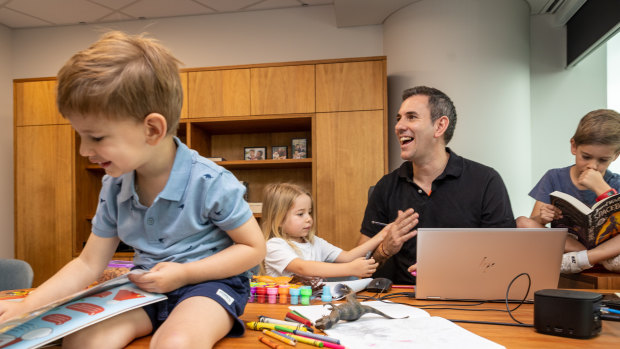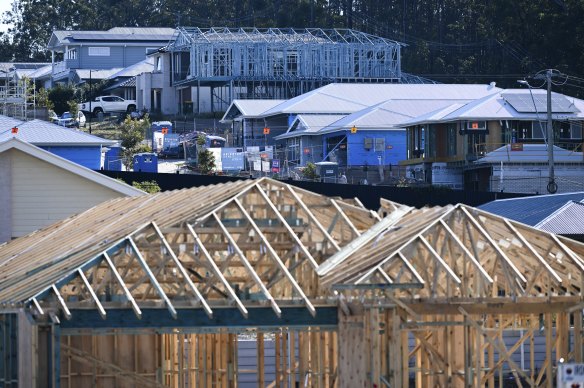- Exclusive
- Politics
- Federal
- Federal budget
This was published 1 year ago
Australia, let’s have more babies, says Jim Chalmers
By Shane Wright and David Crowe
Father-of-three Treasurer Jim Chalmers says he would like to see Australians have more children.
Ahead of next week’s federal budget that will reveal new plans to boost housing for the country’s burgeoning population and forecast a drop in immigration, Chalmers said the government wanted to give people support if they wanted to have children, but ruled out a Peter Costello-style baby bonus.

Treasurer Jim Chalmers prepares for his first budget in 2022 with children Jack (left), Annabel and Leo.Credit: AAP
His comments come as the government prepares to reveal new budget forecasts showing the net migration intake will fall from 518,000 last year to about 260,000 next year, heightening the debate about adding to the population without relying so much on migration.
Channelling former treasurer Peter Costello, who in his 2004 budget urged Australians to “have one for mum, one for dad, and one for the country”, Chalmers said he supported people having more kids.
“It would be better if birth rates were higher,” he said in an interview with this masthead’s podcast The Morning Edition.
“I think people are leaving it later. And sometimes that means you get timed out. But there are a whole range of reasons people’s preferences are changing. It’s expensive to raise kids.”
Australia’s population climbed by 2.5 per cent to 26.8 million over the past year, driven overwhelmingly by a spike in immigration.
But natural population growth – births minus deaths – is falling. It is now 14 per cent lower than 2019, while the fertility rate is down almost 20 per cent since the global financial crisis in 2008.
According to research published by The Lancet in March, Australia’s fertility rate – the number of children a woman can be expected to have in her lifetime – will drop from around 1.63 to 1.45 by 2050 and to 1.32 by 2100. The replacement fertility rate for a population is 2.1.
Chalmers said while he understood the now abandoned baby bonus of the Howard-Costello government, the government believed there were better policies that gave people more choices about their family plans.
He said the government’s policies in areas such as expanded childcare or superannuation on paid parental leave were all aimed at helping parents.
“All of these things are about trying to make it easier for people to have more kids if they want to, and to work more if they want to after they’ve had their kids,” he said.
“People have got different preferences and we want to make it easier for them to make choices in their own interests.”
Chalmers said supplying enough houses for a growing population will be a key issue in next week’s budget.

National cabinet will meet on Friday to discuss more financial support to build houses across the country.Credit: Dan Peled
“That’s because we don’t have enough homes, we need to build more homes for more people, and that requires a bunch of things,” he said.
“It requires more Commonwealth investment, we will do our bit. It requires the states and territories to do their bit, and I’m confident that they will.”
Chalmers said that meant the federal government would spend more on housing over time, saying: “We will do our bit, and we will fund our bit.”
Prime Minister Anthony Albanese has called a national cabinet meeting on Friday to canvass housing policy in a video conference ahead of the budget, raising speculation about new measures and funding deals.
“I don’t want to pre-empt it, but I am prepared to say that we want to work with the states and territories to build more homes,” he said.
“You think about the pressures on rent, how hard it is for people to get into the housing market – we’ve got a responsibility here, and we will meet it.”
The housing policies come as the government admits the pressures in major cities from the influx of overseas students and other migrants.
“What you’ll see in the budget forecast is that net overseas migration next year will be about half what it was last year,” Chalmers said.
The Treasurer said this reflected a fall from the big spike in student numbers last year as well as a shift in tourism after the pandemic, as well as the work by Home Affairs Minister Clare O’Neil to reduce the intake.
The budget forecasts are tipped to show a fall in the net migration intake from 518,000 last financial year to 395,000 in the current financial year.
The revised forecast will show a fall to 260,000 the subsequent year before the intake returns to about 235,000, in line with the annual intake before the pandemic.
Next week’s budget will also upgrade the outlook for the economy, with business investment expected to grow by one per cent in the coming financial year after lifting by 5.25 per cent in 2023-24.
By 2025-26, business investment is tipped to reach $305.7 billion.
If the forecasts prove correct, investment will have climbed for six consecutive years, the longest sustained increase since the early 2000s mining boom. But unlike that period, investment will be driven by non-mining parts of the economy.
The budget will confirm the pressures on the nation’s finances, with it to contain $27.9 billion in savings or reprioritisation of funding. The single largest change, worth $22.5 billion, will be forced on the Defence Department as part of the government’s overhaul of spending across the armed forces.
Chalmers, who is on track to deliver a second successive surplus, has already signalled there will be deficits from 2024-25.
The budget will contain $15.4 billion in “unavoidable” spending to extend programs that were due to end. These include palliative care, cancer support, alcohol and other drug treatment programs.
There will be extra funding for IT covering the aged care system and myGov, fitting-out the new Western Sydney International Airport and for the Home Affairs Department.
Listen to the full interview with Treasurer Jim Chalmers, discussing cost of living relief, housing ambitions and the Future Made in Australia on the Inside Politics podcast.
Cut through the noise of federal politics with news, views and expert analysis from Jacqueline Maley. Subscribers can sign up to our weekly Inside Politics newsletter here.